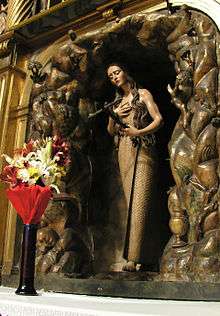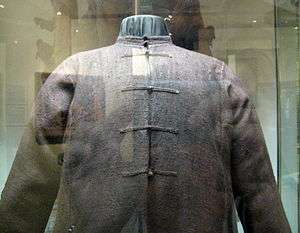Cilice


A cilice /ˈsɪlɪs/, also known as a sackcloth,[1] was originally a garment or undergarment made of coarse cloth or animal hair (a hairshirt) worn close to the skin. It is used by members of various Christian traditions (including some communicants of the Anglican,[2] Catholic,[3] Lutheran,[4] Methodist,[5] and Scottish Presbyterian Churches[6]) as a self-imposed means of repentance and mortification of the flesh; it is often worn during the Christian penitential season of Lent, especially on Ash Wednesday, Good Friday, and other Fridays of the Lenten season.[7]
Cilices were originally made from sackcloth or coarse animal hair so they would irritate the skin. Other features were added to make cilices more uncomfortable, such as thin wires or twigs. In modern religious circles, cilices are simply any device worn for the same purposes.
Etymology
The word derives from the Latin cilicium, a covering made of goat's hair from Cilicia, a Roman province in south-east Asia Minor.[8] The reputed first Scriptural use of this exact term is in the original Latin Vulgate of Psalm 35:13, "Ego autem, cum mihi molesti essent, induebar cilicio." This is translated as hair-cloth in the Douay Bible, and as sackcloth in the King James Version and the Book of Common Prayer ("But as for me, when they were sick, my clothing was sackcloth." in the King James Bible). Sackcloth is often mentioned in the Bible as a symbol of mourning and penance, and was probably a form of hairshirt. Sackcloth may also mean burlap. However, sackcloth in the Bible was usually made of coarse, black goat's hair.
Use

There is some evidence, based on analyses of both clothing represented in art and preserved skin imprint patterns at Çatalhöyük in Turkey, that the usage of the cilice predates written history. This finding has been mirrored at Göbekli Tepe, another Anatolian site, indicating the widespread manufacturing of cilices. Ian Hodder has argued that "self-injuring clothing was an essential component of the Catalhöyük culturoritual entanglement, representing 'cleansing' and 'lightness'."[9]
To show deep repentance, it was the custom in Biblical times in the Jewish religion to wear a hairshirt (sackcloth) as a sign of repentance and atonement (Genesis 37:34, 2 Samuel 3:31, Esther 4:1), but not in order to cause harm to oneself, which is forbidden in the Jewish religion. In the Christian Bible, the prophets Elijah and John the Baptist wore sackcloth woven from "the hair of horses, and coarsest hair of camels and goats".[10] Such garments or adornments have been worn at various times in the history of the Christian faith, to mortify the flesh or as penance for adorning oneself. Being made of rough cloth, generally woven from goats' hair, and worn close to the skin, they would feel very itchy.
Thomas Becket was wearing a hairshirt when he was martyred, St. Patrick reputedly wore a cilice, Charlemagne was buried in a hairshirt, and Henry IV, Holy Roman Emperor and King of Germany, famously wore one in the Walk to Canossa during the Investiture Controversy. Prince Henry the Navigator was found to be wearing a hairshirt at the time of his death in 1460. They have been used for centuries in the Catholic Church as a mild form of bodily penance, like fasting. St. Francis of Assisi, St. Ignatius Loyola and St. Therese of Lisieux are known to have used them. In modern times they have been used by Mother Teresa, St. Padre Pio, and Pope Paul VI.[11] The Discalced Carmelite convent of St. Teresa in Livorno, Italy, members of Opus Dei who are celibate (about 30% of the membership), and the Franciscan Brothers and Sisters of the Immaculate Conception continue an ascetic use of the cilice.[12] According to John Allen, an American Catholic writer, its practice in the Catholic Church is "more widespread than many observers imagine".[13]
Some high church Anglicans, including Edward Bouverie Pusey, wear hair shirts as a part of their spirituality.[2] In the Presbyterian Church of Scotland, influenced by the evangelical revival, penitents were dressed in sackcloth and called in front of the chancel, where they were asked to admit their sins.[6]
It was in common use in monasteries and convents throughout history up until the 1960s, and has been endorsed by popes as a way of following Christ, who died in a bloody crucifixion and who gave this advice: "Let him deny himself, take up his cross daily and follow me."[14][15] Supporters say that opposition to mortification is rooted in having lost (1) the "sense of the enormity of sin" or offense against God, and the consequent penance, both interior and exterior, (2) the notions of "wounded human nature" and of concupiscence or inclination to sin, and thus the need for "spiritual battle",[16] and (3) a spirit of sacrifice for love and "supernatural ends", and not only for physical enhancement.
In some Methodist churches, on Ash Wednesday, communicants, along with receiving ashes, also receive a piece of sackcloth "as a reminder of our own sinful ways and need for repentance".[17]
In popular culture

In Dan Brown's novel The Da Vinci Code, one of the antagonists, an albino numerary named Silas associated with the religious organization Opus Dei, wears a cilice in the form of a spiked chain around his thigh. The sensationalized depiction in the novel has been criticized for its inaccuracy in subsequent books and by Opus Dei itself, which issued a press release responding to the movie's depiction of the practice, claiming "In reality, they cause a fairly low level of discomfort comparable to fasting. There is no blood, no injury, nothing to harm a person's health, nothing traumatic. If it caused any harm, the Church would not allow it."[11][18]
In Molière's play, Tartuffe, the title character is shown to be a hypocrite when he wears a hair shirt with the hair lining facing outward, so that it can be seen, rather than felt.
The Marvel Comics character Robbie Baldwin commissioned the creation of a suit with 612 internal spikes to represent each person who died in an explosion for which he felt responsible, so that he would be reminded of their pain in everything he did.
In Gustave Flaubert's "The Legend of St. Julian the Hospitaler", Julian wears a hair shirt with iron spikes to do penance for his parricide.
In Flannery O'Connor's novel Wise Blood, the protagonist Hazel Motes is discovered by his landlady to be wearing a barbed wire cilice around his torso after he has blinded himself. She also finds that he has been walking miles each day with small rocks and glass in the bottom of his shoes.
In George R. R. Martin's series A Song of Ice and Fire, members of the militant branch of the Faith of the Seven known as Warrior's Sons and Poor Fellows commonly wear hair shirts. The High Septon appointed in A Feast for Crows known as the High Sparrow also wears one.
In the U.S. WGN America television series Salem, Increase Mather is shown wearing a metal cilice in season 1, episodes 10 and 11.
In Hilary Mantel's Wolf Hall, Sir Thomas More wears a hair shirt as is repeatedly mentioned by the narrator, Thomas Cromwell.
In The Nun, the main character Suzanne, when pressured to wear a cilice by the new mother superior, hastily throws it into a fire.
In Ken Follett's The Pillars of the Earth several characters, including Thomas Becket, are described as wearing hairshirts.
In The Walking Dead, the priest, Gabriel, in season 5 mentions the making of and wearing a hair shirt to atone for sins.
R.E.M. released the song "Hairshirt" on their 1988 album Green.
The Birthday Party released the song "The Hair Shirt" on their 1980 album The Birthday Party.
In Barenaked Ladies song "What a Good Boy", singer Steven Page sings about a hair shirt.
Pile released an album in 2017 called "A Hairshirt of Purpose".
In Philippa Gregory's novel The King's Curse Katherine of Aragon and several other characters are described as wearing hair shirts. In her "Three Sisters, Three Queens" King James IV of Scotland wears a cilice consisting of "a circlet of metal rings around his waist".
In Parks and Recreation, Ron Swanson mentions a hair shirt when Leslie is being interrogated by government officials.[19]
See also
References
- ↑ Jeffrey, David L. (1992). A Dictionary of Biblical Tradition in English Literature. Wm. B. Eerdmans Publishing. p. 673. ISBN 9780802836342.
- 1 2 Knight, Mark; Mason, Emma (16 November 2006). Nineteenth-Century Religion and Literature: An Introduction. Oxford University Press. p. 96. ISBN 9780191535017.
Pusey regularly endured a hair shirt as well as self- imposed flagellation and fasting routines.
- ↑ Stravinskas, Peter M. J.; Shaw, Russell B. (1998). Our Sunday Visitor's Catholic Encyclopedia. Our Sunday Visitor Publishing. p. 483. ISBN 9780879736699.
- ↑ Neve, Juergen Ludwig (1914). The Augsburg Confession: A Brief Review of Its History and an Interpretation of Its Doctrinal Articles, with Introductory Discussions on Confessional Questions. Lutheran Publication Society. p. 150.
|access-date=requires|url=(help) - ↑ Bergen, Jeremy M. (31 March 2011). Ecclesial Repentance: The Churches Confront Their Sinful Pasts. A&C Black. p. 255. ISBN 9780567523686.
In fact, it was scandal of disunity within Methodism that led UMC leaders to address the issue of racism as the underlying cause. ... The petition for forgiveness proceeded on two distinct but interrelated levels. Each of the approximately 3,000 persons in the assemble was called to silent personal confession of the sin of racism before God, publicly symbolized by receiving ... sackcloth ... and the imposition of ashes.
- 1 2 Yates, Nigel (11 June 2014). Eighteenth Century Britain: Religion and Politics 1714-1815. Routledge. p. 87. ISBN 9781317866480.
The Evangelical revival in Scotland encouraged both much stricter conditions being placed on admission to Holy Communion and the maintenance of traditional discipline within the established church. ... Lesser transgressors could be ordered by the kirk session to stand before the congregation for up to three Sundays, sometimes wearing sackcloth, and publicly acknowledge their sins before 'being subjected to a "rant" from the minister'.
- ↑ Beaulieu, Geoffrey of; Chartres, William of (29 November 2013). The Sanctity of Louis IX: Early Lives of Saint Louis by Geoffrey of Beaulieu and William of Chartres. Cornell University Press. p. 89. ISBN 9780801469145.
- ↑ "Cilice". Online Etymology Dictionary. Retrieved 2012-06-30.
- ↑ Ian Hodder, "Çatalhöyük: The Leopard's Tale", Thames & Hudson, 2006.
- ↑ Malcom, Howard (1831). A Dictionary of Important Names, Objects, and Terms, Found in the Holy Scriptures: Intended Principally for Youth. Lincoln & Edmands. p. 197.
Sackcloth, was a coarse cloth, made of the hair of horses, and coarsest hair of camels and goats. It was the common clothing of very poor people, and was much used for tents, awnings, &c. Elijah and John the Baptist wore such; indeed, it was anciently very common for all prophets to be thus humbly clad.
|access-date=requires|url=(help) - 1 2 "Opus Dei". opusdei.us. 17 May 2006.
- ↑ Allen 2006, pp. 165, 169, 171–173.
- ↑ Allen 2006, p. 173.
- ↑ Luke 9:23
- ↑ "The Da Vinci Code, the Catholic Church and Opus Dei". Opus Dei Official Site. Retrieved 2006-11-27.
- ↑ "The consequences of Adam's sin for humanity". Catechism of the Catholic Church no. 405. Archived from the original on 2007-06-30. Retrieved 2007-06-13.
- ↑ Ice, Roy E. (11 March 2017). "Sackcloth". St Paul's United Methodist Church. Retrieved 27 March 2017.
- ↑ Allen 2006, pp. 162–163.
- ↑ Michael McCullers (director) (April 30, 2009). "Boys' Club". Parks and Recreation. Season 1. NBC.
- Allen Jr., John (2006). Opus Dei: An Objective Look Behind the Myths and Reality of the Most Controversial Force in the Catholic Church. Double Day.
External links
| Look up cilice in Wiktionary, the free dictionary. |
- The Catholic Encyclopedia on hairshirts
- On the Latin word cilicium (with photograph of a 16c hairshirt)
- Suffering and Sainthood in the Catholic Church The importance of Penance and Mortification for those who desire to become a Catholic Saint
